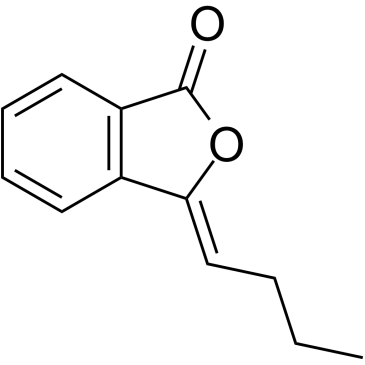3-Butylidenephthalide

3-Butylidenephthalide structure
|
Common Name | 3-Butylidenephthalide | ||
|---|---|---|---|---|
| CAS Number | 551-08-6 | Molecular Weight | 188.223 | |
| Density | 1.2±0.1 g/cm3 | Boiling Point | 312.0±35.0 °C at 760 mmHg | |
| Molecular Formula | C12H12O2 | Melting Point | N/A | |
| MSDS | Chinese USA | Flash Point | 127.9±23.4 °C | |
| Symbol |

GHS07 |
Signal Word | Warning | |
|
Identification of Aroma-active Compounds in Essential Oil from Uncaria Hook by Gas Chromatography- Mass Spectrometry and Gas Chromatography-Olfactometry.
J. Oleo Sci. 64 , 825-33, (2015) The chemical composition of essential oil extracted from Uncaria Hook ("Chotoko" in Japanese), the branch with curved hook of the herbal medicine Uncaria rhynchophylla has been investigated by GC and GC-MS analyses. Eighty-four compounds, representing 90.8% o... |
|
|
Cinidium officinale and its Bioactive Compound, Butylidenephthalide, Inhibit Laser-Induced Choroidal Neovascularization in a Rat Model.
Molecules 20 , 20699-708, (2015) Choroidal neovascularization (CNV) is a common pathology in age-related macular degeneration. In this study, we evaluated in a rat model the effect of an extract of Cinidium officinale Makino and its bioactive compound, butylidenephthalide, on laser-induced C... |
|
|
(Z)-3-butylidenephthalide from Ligusticum porteri , an α-glucosidase inhibitor.
J. Nat. Prod. 74 , 314-20, (2011) An extract from the roots of Ligusticum porteri, orally administered to groups of normal and diabetic mice, showed significant hypoglycemic and antihyperglycemic effects. Experimental type-II DM was achieved by treating mice with streptozotocin 15 min after a... |
|
|
The natural compound n-butylidenephthalide derived from Angelica sinensis inhibits malignant brain tumor growth in vitro and in vivo.
J. Neurochem. 99(4) , 1251-62, (2006) The naturally-occurring compound, n-butylidenephthalide (BP), which is isolated from the chloroform extract of Angelica sinensis (AS-C), has been investigated with respect to the treatment of angina. In this study, we have examined the anti-tumor effects of n... |
|
|
Synergistic interaction between the Ligusticum chuanxiong constituent butylidenephthalide and the nitric oxide donor sodium nitroprusside in relaxing rat isolated aorta.
J. Ethnopharmacol. 122(2) , 308-12, (2009) Ligusticum chuanxiong Hort. (Umbelliferae), a traditional Chinese medicinal herb, is often prescribed together with nitric oxide donors for treating coronary heart diseases such as angina in China; however, studies concerning their pharmacological interaction... |
|
|
Orphan nuclear receptor, Nurr-77 was a possible target gene of butylidenephthalide chemotherapy on glioblastoma multiform brain tumor.
J. Neurochem. 106(3) , 1017-26, (2008) The natural compound n-butylidenephthalide (BP), which is isolated from the chloroform extract of Angelica sinensis, has been investigated for its antitumoral effects on glioblastoma multiform (GBM) brain tumors both in vitro and in vivo. To determine the mec... |
|
|
Brain tumor senescence might be mediated by downregulation of S-phase kinase-associated protein 2 via butylidenephthalide leading to decreased cell viability.
Tumour Biol. 35(5) , 4875-84, (2014) Developing an effective drug for treating human glioblastoma multiform (GBM) has been investigated persistently. A pure compound butylidenephthalide (BP), isolated from Angelica sinensis, has been shown the activities to arrest the growth and initiate apoptos... |
|
|
n-Butylidenephthalide induced apoptosis in the A549 human lung adenocarcinoma cell line by coupled down-regulation of AP-2alpha and telomerase activity.
Acta Pharmacol. Sin. 30(9) , 1297-306, (2009) To investigate the role of hTERT gene expression and AP-2alpha in n-butylidenephthalide (n-BP)-induced apoptosis in A549 lung cancer cells.Viability of A549 cells was measured by MTT assay. Protein expression was determined by Western blot. Telomerase activit... |
|
|
Local interstitial delivery of z-butylidenephthalide by polymer wafers against malignant human gliomas.
Neuro. Oncol. 13(6) , 635-48, (2011) We have shown that the natural compound z-butylidenephthalide (Bdph), isolated from the chloroform extract of Angelica sinensis, has antitumor effects. Because of the limitation of the blood-brain barrier, the Bdph dosage required for treatment of glioma is r... |
|
|
n-Butylidenephthalide (BP) maintains stem cell pluripotency by activating Jak2/Stat3 pathway and increases the efficiency of iPS cells generation.
PLoS ONE 7(9) , e44024, (2012) In 2006, induced pluripotent stem (iPS) cells were generated from somatic cells by introducing Oct4, Sox2, c-Myc and Klf4. The original process was inefficient; maintaining the pluripotency of embryonic stem (ES) and iPS cell cultures required an expensive re... |